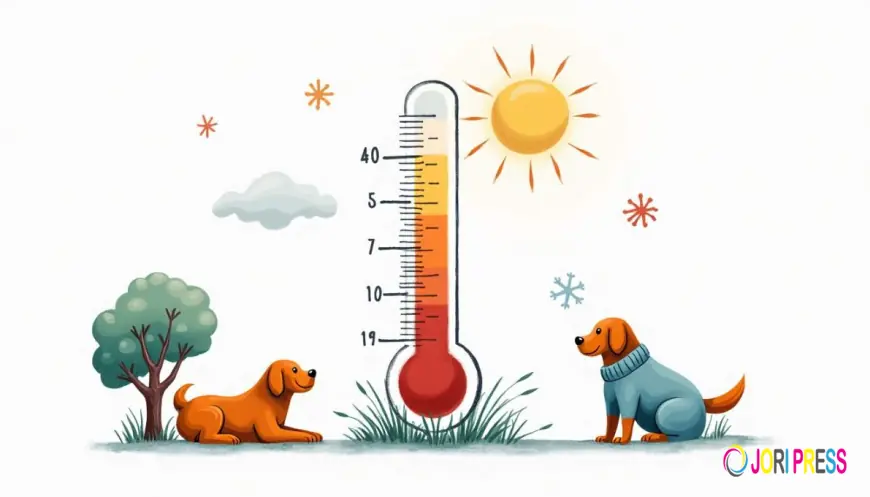When Is It Too Hot (or Cold) to Walk Your Dog?

Walking your dog is one of the best ways to keep them healthy, happy, and well-socialized. But as temperatures swing to extremes, many pet owners wonder: when is it too hot or too cold to take their furry friend outside? Understanding how weather affects dogs is crucial to ensuring their safety and comfort during walks. This article explores the signs to watch for, temperature guidelines, and practical tips to keep your dog safe in both scorching heat and biting cold.
Understanding How Weather Affects Dogs
Dogs don’t regulate temperature the same way humans do. While people sweat to cool down, dogs primarily rely on panting and limited sweat glands on their paw pads. This means they can overheat or get too cold much faster than we might expect. Factors such as breed, size, age, and health also play a significant role in how weather impacts your dog.
For example, brachycephalic breeds like Bulldogs and Pugs have shorter snouts, making it harder for them to breathe and cool down through panting. Similarly, small or short-haired dogs may be more vulnerable to cold temperatures, while large, thick-coated breeds can handle colder weather better but may struggle in the heat. Additionally, age can be a critical factor; young puppies and older dogs may not have the same resilience as their adult counterparts, making them more susceptible to temperature extremes.
The Risks of Walking in Extreme Heat
Heatstroke is a serious and potentially fatal condition for dogs. When temperatures rise, your dog’s body temperature can quickly reach dangerous levels, especially if they are exercising or exposed to direct sunlight. Signs of heatstroke include excessive panting, drooling, weakness, vomiting, and collapse. If you notice any of these symptoms, it’s critical to get your dog to a cooler environment and seek veterinary care immediately. To prevent heat-related issues, it’s advisable to walk your dog during the cooler parts of the day, such as early morning or late evening, and always have fresh water available for hydration.
The Dangers of Walking in Extreme Cold
On the flip side, cold weather can cause hypothermia and frostbite in dogs. Hypothermia occurs when a dog’s body temperature drops below normal, leading to lethargy, shivering, and in severe cases, unconsciousness. Frostbite typically affects the extremities such as ears, paws, and tail, causing tissue damage. Dogs with thin coats, puppies, elderly dogs, and those with certain medical conditions are particularly at risk. It’s important to monitor your dog closely during winter walks; if they seem uncomfortable or reluctant to walk, it may be time to head back indoors. Additionally, consider using dog sweaters or booties to help protect them from the cold, especially for those breeds that are not naturally equipped to handle low temperatures. For more winter care tips and high-quality pet accessories, visit Four Dog Paws.
Temperature Guidelines: When to Walk and When to Stay In
While there’s no one-size-fits-all answer, general temperature guidelines can help you decide when it’s safe to walk your dog.
Hot Weather: The 70-Degree Rule and Pavement Test
Many veterinarians recommend avoiding walks when temperatures rise above 85°F (29°C), especially during midday. However, it’s not just the air temperature to consider—pavement and asphalt can become scorching hot and burn your dog’s paw pads. A simple test is to place the back of your hand on the pavement for seven seconds. If it’s too hot for your hand, it’s too hot for your dog’s paws.
Early morning or late evening walks are safer during hot months, as temperatures tend to be cooler and the sun less intense. Additionally, always bring water for your dog and take frequent breaks in shaded areas. Dogs can easily overheat, so watch for signs of distress such as excessive panting, drooling, or lethargy. If you notice any of these symptoms, it’s crucial to find a cool place and offer water immediately. Moreover, consider engaging in indoor activities on particularly hot days, such as playing fetch in a climate-controlled environment or practicing obedience training to keep your dog mentally stimulated.
Cold Weather: When to Limit Outdoor Time
Dogs can generally tolerate temperatures down to about 45°F (7°C) without much trouble, but this varies widely. When temperatures drop below freezing (32°F or 0°C), it’s important to monitor your dog closely and limit outdoor time, especially for small, short-haired, or elderly dogs.
For extremely cold days, consider shorter walks and protective gear like dog sweaters or booties. If it’s icy or snowy, be cautious of salt and chemicals on sidewalks, which can irritate paws. Additionally, be aware that some breeds are more susceptible to cold than others; for instance, Greyhounds and Chihuahuas may require extra layers, while Huskies and Malamutes are built for colder climates. Always check your dog’s ears, paws, and tail for signs of frostbite after a walk, as these areas are particularly vulnerable. When staying indoors, engage your dog with interactive toys or puzzles to keep them entertained and active during the chilly months.
Signs Your Dog Is Uncomfortable in the Heat or Cold
Even if the temperature seems safe, your dog may still be uncomfortable or at risk. Learning to recognize warning signs can prevent serious health issues. Dogs, much like humans, have their own thresholds for temperature discomfort, and these can vary widely depending on factors such as breed, age, and overall health. For instance, brachycephalic breeds like Bulldogs and Pugs are particularly susceptible to heat stress due to their short snouts, which can hinder their ability to cool down effectively. Conversely, small or short-haired breeds may struggle more in cold weather, as they lack the natural insulation that larger or long-haired breeds possess. Understanding your dog's specific needs is crucial in keeping them comfortable throughout the year.
Heat-Related Warning Signs
- Excessive panting or difficulty breathing
- Drooling more than usual
- Bright red or pale gums
- Weakness or staggering
- Vomiting or diarrhea
- Confusion or collapse
If you observe any of these symptoms, stop the walk immediately, move your dog to a cool place, and offer water. Contact your veterinarian if symptoms persist. It's also important to remember that certain times of the day, such as midday when the sun is at its peak, can be particularly hazardous for your dog. Consider scheduling walks during cooler parts of the day, like early morning or late evening, and always carry water to keep your furry friend hydrated. Additionally, providing shade and a cool place to rest during outdoor activities can help alleviate the risk of heat-related issues.
Cold-Related Warning Signs
- Shivering or trembling
- Whining or anxious behavior
- Slowed movements or reluctance to walk
- Cold or pale extremities
- Frostbite signs: pale, hard, or discolored skin on ears, tail, or paws
When you notice these signs, it’s best to cut the walk short and warm your dog gradually. Avoid using direct heat sources like heating pads, which can cause burns. Instead, consider wrapping your dog in a warm blanket or using a pet-safe heated bed to help them regain their body temperature. Additionally, be mindful of the surfaces your dog walks on; cold pavement or snow can be harsh on their paws, leading to discomfort or even injury. Booties designed for winter weather can provide extra protection and help your dog feel more comfortable during chilly outings. Always monitor your dog's behavior closely, as they may not vocalize their discomfort as clearly as we might expect.
Practical Tips for Walking Your Dog Safely in Extreme Weather
Preparation and awareness are key to keeping your dog safe during walks in hot or cold weather. Here are some practical strategies to consider:
Walking in Hot Weather
- Choose the right time: Walk early in the morning or late at night when temperatures are cooler.
- Stay on grass or shaded paths: Avoid hot pavement that can burn paws.
- Bring water: Carry a portable water bowl and offer frequent sips to keep your dog hydrated.
- Use cooling gear: Consider cooling vests or bandanas designed for dogs.
- Watch for signs of overheating: Stop and rest if your dog shows any distress.
Walking in Cold Weather
- Dress your dog: Use sweaters or coats for small, short-haired, or elderly dogs.
- Protect paws: Dog booties can shield paws from ice, salt, and cold surfaces.
- Limit walk time: Shorten walks on very cold days and keep moving to maintain body heat.
- Check paws after walks: Clean off any salt or chemicals and inspect for cracks or irritation.
- Provide a warm resting place: Ensure your dog has a cozy spot to warm up after outdoor time.
Special Considerations for Different Dog Types
Not all dogs tolerate temperature extremes equally. Understanding your dog’s unique needs can help you tailor your walking routine accordingly.
Breed and Coat Type
Thick-coated breeds like Huskies, Malamutes, and Saint Bernards are built for cold weather and can handle lower temperatures better than short-haired breeds like Chihuahuas or Greyhounds. Conversely, short-nosed breeds such as Bulldogs and Pugs are more prone to heat exhaustion and should be walked during cooler parts of the day.
Age and Health
Puppies and senior dogs often have less stamina and may be more sensitive to temperature extremes. Dogs with heart or respiratory conditions, arthritis, or obesity also require extra caution. Consult your veterinarian for personalized advice if your dog has special health considerations.
Size Matters
Smaller dogs generally lose body heat faster and may need more protection in cold weather. Larger dogs can sometimes overheat more quickly during warm weather due to their size and muscle mass.
Alternative Exercise Options When Weather Is Too Extreme
When it’s simply too hot or cold to walk your dog safely, there are other ways to keep them active and mentally stimulated indoors.
Indoor Playtime
Games like fetch, tug-of-war, or hide-and-seek can provide physical exercise without exposing your dog to dangerous temperatures. Puzzle toys and treat-dispensing balls also engage your dog’s mind.
Training Sessions
Use indoor time to teach new commands or tricks. Training not only tires out your dog mentally but also strengthens your bond.
Doggy Daycare or Indoor Dog Parks
If available, doggy daycare centers or indoor dog parks offer safe environments for exercise and socialization when outdoor conditions are unsafe.
Conclusion
Walking your dog is an essential part of their daily routine, but extreme temperatures require careful consideration. By understanding how heat and cold affect dogs, recognizing warning signs, and adapting your walks accordingly, you can protect your furry friend from harm. Always prioritize your dog’s comfort and safety, and when in doubt, opt for shorter walks or indoor activities. Your dog will thank you for keeping their health and happiness front and center, no matter the weather.
What's Your Reaction?
 Like
0
Like
0
 Dislike
0
Dislike
0
 Love
0
Love
0
 Funny
0
Funny
0
 Angry
0
Angry
0
 Sad
0
Sad
0
 Wow
0
Wow
0




















































